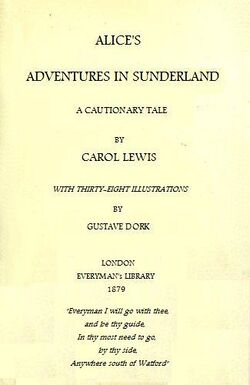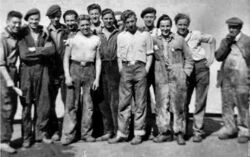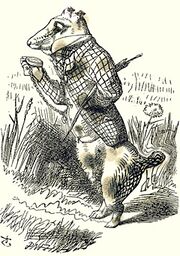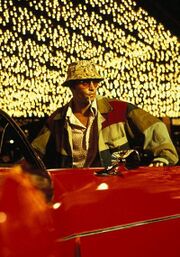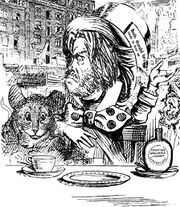Alice in Sunderland
Alice's Adventures in Sunderland (1879) is a seminal cautionary Realist novel written by the English author Earl Edward Henry Hardwicke III under the pseudonym Carol Lewis. It is generally considered to be the pinnacle of the so-called Purification Movement, which typically offset virtuous upper-class Victorians against their smelly, dimwitted working class counterparts through a series of unsavoury and unhygienic encounters, in the process exposing the ungodly ways of the Northern proletariat.
Lewis' tale - which set the blueprint for the genre - tells the timeless tale of a young girl named Alice who by some horrific accident of fate wakes up in an abandoned dockyard in Sunderland, a macabre world populated by peculiar and anthropomorphic creatures. The remainder of the novel recounts the heroine's courageous attempts to escape the Mackem hellhole without being talked to, touched, or breathed upon by any of the hideous inhabitants.
Background
Alice was written in 1879, the year Northern men were granted the same civil rights as the other great apes[1]. Outraged by this development, Lewis resolved to write a work of fiction to show the filthy creatures as they really were, and began a tour of what he called Britannia Inferior in order to carry out research for this lofty task.
On the course of his tour, Lewis visited many different towns and villages in preparation, his notes from the era indicate that he frequented many notable establishments of the day. Historians consider the author's notes to be unreliable however, as he seemed unable to distinguish taverns from homeless shelters, or schools from prisons. Lewis generally referred to all of them as 'bellyflops'; a characteristically clever play on the colloquial term 'dive' (scholars have speculated that the writer thought 'dive' had too many connotations of gracefulness to be used in this context).
Part of the author's travels included sailing up the River Wear in a boat, accompanied by three young girls who were friends of the family. The locals took a liking to the girls, especially little Alice, who was the middle child. As Lewis recalls:
| “ | Alice, being the silly and carefree child she is, thought it would be a good idea to engage one of the vulgar little halflings. Imagine her shock when one of them yelled back asking to see her 'rabbit hole' of all things. She was shocked and confused, and I was naturally appauled. However it was this moment that I was inspired, and the novel first manifested itself in my head. | ” |
Following this incident, the author created the fictitious world of Sunderland[2], taking inspiration from both his travels through The North and his own nightmares about travelling through The North. He began writing Alice in Sunderland that very night, and at this early stage he had already decided to dedicate the book to the real-life Alice, who had died of shock on the way home to London.
Characters
Alice: A precocious young girl who tires of the Victorian life of privilege and repression, so follows a white ferret through a tunnel to another world, only to realise she was better off where she started. Alice finds Sunderland a confusing, nonsensical place, and cannot understand its inhabitants' seemingly made-up language, nor their love of keeping pigeons.
The White Ferret: Rabid, smelly and flea-ridden, the Ferret wears a posh waistcoat and carries a gold watch at all times. Lewis notes that Northerners would often train their pets to steal from unsuspecting Londoners, which is how the creature came to procure such luxury items. Alice was initially under the impression that the ferret could talk, but soon remembered that not even the locals are capable of verbal communication, never mind the animals. Whatever the case, the White Ferret was apparently late for a very important date. What this "date" is actually for is never discussed, although Alice hopes that it will involve some kind of treatment for rabies.
The Mad Hatter: The local hat maker/wearer. Alice finds him having a tea party, which upsets her greatly as it is not officially tea time according to GMT. This matters not however, because when he hands her the supposed "tea" it turns out to be a jug of pale ale.
The Hatter is truly mad - his mind rotted by Syphilis - and as such hallucinates his guests to be a dormouse and a March hare, when in fact they are the mangled cadavers of his wife and kids.
The Cheshire Man: The man from Cheshire is one of the most iconic characters from the novel. He appears before Alice in a dark alleyway, and as such, the only visible part of him is his pearly grin, illuminated in the moonlight. Alice remarks at this point that she's seen a man without a smile, but never a smile without a man, and speculates that he must be very poor indeed not to be able to afford a physical form. They later share the memorable exchange:
Alice: "I loathe this place. Everything here's so Northern."
Cheshire Man: "Why yes, everyone here is Northern."
Alice: "Well I'm not."
Cheshire Man: "But of course you are, or why else would you be here?"
Alice: "How dare you."
The Cheshire Man is one of the few Northern characters who actually has teeth. In the novel, Lewis portrays Cheshire as not being a proper Northern county, but a nice posh Southern one that got separated from the group, and somehow found its way Up North. There is a lengthy poem in the novel detailing this.
The Caterpillar: Codename for the local drug dealer, so named for his thin, black moustache that resembles a larval Lepidoptera. When Alice meets him he is smoking a hookah amongst the flowers. He constantly belittles her, and blows his foul smelling shisha smoke in her face. At one point he also force feeds her mushrooms in an attempt to get her hooked to his product. These incredibly potent fungi make her believe she is shrinking and growing uncontrollably.
Mock Turtle: Upon meeting the creature, Alice complains that she's never heard of a mock turtle. One of the locals then explains that it's what mock turtle soup is made from. As his name suggests, the Mock Turtle is not a turtle at all, but merely a whippet in a flat-cap. Presumably, the residents of Sunderland were unable to afford such an exotic pet.
Critical Reception
Although the novel has since gained legendary status, not all the initial reviews were positive. For instance, many critics disliked the episodic nature of the plot. One said; "the book is little more than a series of isolated encounters, it has no tension and no pay-offs". Lewis responded by saying that this reflects life in the North. Another review described it as "a long and monotonous blur that lacks any kind of direction". Again, Lewis pointed out that this is very much like Northern life.
In recent years the book has come under some scrutiny for its unsubtle anti-Northern leanings. Several detractors have pointed out that the novel unfairly portrays people from Up North as stupid, lazy, ugly, inbred and destined to be working class throughout their lives. It is generally accepted today that, if any of them could read, they would be deeply offended by it.
See Also
Footnotes
| Featured version: 3 January 2011 | |
| This article has been featured on the main page. — You can vote for or nominate your favourite articles at Uncyclopedia:VFH. | |
